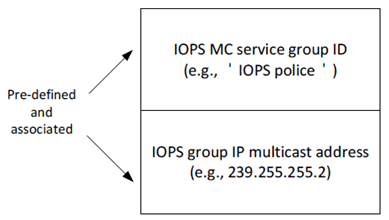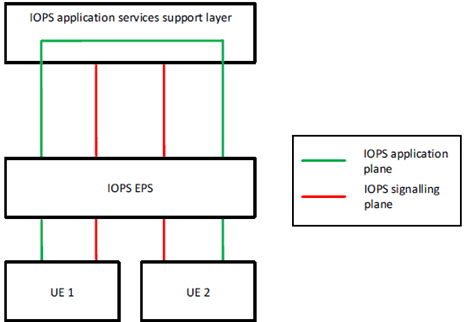Content for TS 23.180 Word version: 18.0.0
8 Identities
8.1 Application plane
9 Application of functional model to deployments
9.1 Overview
9.2 IOPS architectural model diagram
...
...
8 Identities p. 17
8.1 Application plane p. 17
8.1.1 IOPS MC user identity (IOPS MC ID) p. 17
8.1.1.1 General p. 17
The IOPS MC ID is used for identifying an MC user in the IOPS mode of operation. The IOPS MC ID uniquely identifies an MC user on the IOPS MC system.
The IOPS MC ID can be used for the user authentication with the IOPS MC system.
8.1.2 IOPS MC service user identity (IOPS MC service ID) p. 17
8.1.2.1 General p. 17
8.1.3 IOPS MC service group identity (IOPS MC service group ID) p. 17
8.1.3.1 General p. 17
An IOPS MC service group ID is used for identifying an MC service group in the IOPS mode of operation. The MC service UE is able to make one or more MC service communications (as per the group configuration) with other member UEs whose users are within the same IOPS MC service group ID.
The general description of an MC service group ID is provided in TS 23.280.
8.1.3.2 IOPS MC service group ID management (IP connectivity functionality) p. 17
Figure 8.1.3.2-1 illustrates how the IOPS MC service group ID and the IOPS group IP multicast address are mapped to each other for the support of the IP connectivity functionality. The IOPS group IP multicast address is pre-configured in the MC service UEs supporting the IOPS mode of operation in accordance with the IOPS MC service group ID.

Figure 8.1.3.2-1: IOPS MC service group ID management (IP connectivity functionality)
(⇒ copy of original 3GPP image)
(⇒ copy of original 3GPP image)
9 Application of functional model to deployments p. 18
9.1 Overview p. 18
The IOPS architectural model includes application functions at the IOPS MC system and UEs to support MC services in the IOPS mode of operation during a backhaul failure. The IOPS MC system provides MC services support to the MC service UE via a single PLMN dedicated to the IOPS mode of operation. The IOPS mode of operation is described in TS 23.401.
The architectural model to support MC services in the IOPS mode of operation consists of a signalling control plane and an application plane. The signalling control plane provides the necessary signalling support for the related IOPS application layer transactions, e.g. the registration and discovery of UEs on the IOPS MC system. The IOPS application plane provides the necessary support for the transport of the IOPS operation related application data as well as the IP packets containing the MC service application data to be distributed via the IOPS MC system.
The MC service application data includes all signalling control data and application data (control and media) required to provide MC services between MC service clients. The IP related transmissions are established over the IOPS MC system via IP unicast and multicast transmissions.
9.2 IOPS architectural model diagram p. 18
Figure 9.2-1 shows the IOPS architectural model for the IOPS MC system solution in case of a backhaul failure.

9.2.1 IOPS application services support layer p. 19
The IOPS MC system is composed of the following functional entities for the support of MC services in the IOPS mode of operation:
- an IOPS MC connectivity function as described in clause 7.4.1.3, an IOPS distribution function as described in clause 7.4.1.4 and a signalling application server as described in clause 7.4.2.2.
9.2.2 IOPS EPS p. 19
The IOPS EPS provides point-to-point and point-to-multipoint bearer services with QoS in the IOPS mode of operation, as described in TS 23.401.
9.2.3 UE 1 p. 19
The UE 1 is an MC service UE supporting the IOPS mode of operation. It supports bearer services and applications to provide MC services over the IOPS MC system. The UE 1 is composed of the following functional entities:
- for MC services over the IOPS MC system, MC service client(s) as described in clause 7.4.1.5;
- for IOPS application plane, an IOPS connectivity client as described in clause 7.4.1.2; and
- for IOPS signalling control, a signalling user agent as described in subclause 7.4.2.1.
9.2.4 UE 2 p. 19
The UE 2 represents one or more UEs with the same functionality as UE 1.